What is Modern Slavery?
Modern Slavery is a crime in which people are treated as commodities and exploited for criminal gain. It can encompass slavery, servitude, forced and compulsory labour and human trafficking.
Slavery: To exercise “ownership” over an individual.
Forced or Compulsory Labour: Force an individual to provide work or a service. The work/service is NOT freely given.
Servitude: An aggravated form of Forced or Compulsory Labour with a degree of permanence.
Human Trafficking:
The terms ‘human trafficking ‘and ‘modern slavery’ are often used interchangeably. However, there is a distinction: the Modern Slavery Act differentiates human trafficking offences from offences of slavery, servitude and forced or compulsory labour. The government has described the difference as follows:
| For a person to have been a victim of human trafficking there must have been; | For a person to have been a victim of slavery, servitude and forced or compulsory labour there must have been: |
| Action (recruitment, transportation, transfer, harbouring or receipt, which can include either domestic or cross border movement) Means (threat or use of force, coercion, abduction, fraud, deception, abuse of power or vulnerability – however, there does not need to be a means used for children as they are not able to give informed consent) Purpose of exploitation (e.g. sexual exploitation, forced labour or domestic servitude, slavery, financial exploitation, illegal adoption, removal or organs) | Means (being held, either physically or through threat of penalty – e.g. threat or use of force, coercion, abduction, fraud, deception, abuse of power or vulnerability. However, there does not need to be a means used for children as they are not able to give informed consent) Service (an individual provides a service for benefit, e.g. begging, sexual services, manual labour, domestic service) |
Human Trafficking and children
A child (under 18) cannot consent to their own exploitation. As such, we only need to show “the Action” and “the Purpose”. A child’s actions can appear entirely voluntarily, but this does not make them any less of a victim. We do NOT need to show that a child has been forced, threatened, coerced etc. (the Means) for an offence to be complete.
Forced or compulsory labour may be present in trafficking cases. However, not every person who is exploited through forced labour has been trafficked.
Within the term “Human Trafficking” the intended exploitation not only includes Slavery, Forced Labour and Servitude but also includes:
Sexual exploitation includes abuse, forced prostitution and the abuse of children for the production of child abuse images/videos.
Domestic servitude involves a victim being forced to work, usually in private households, performing domestic chores and childcare duties.
Criminal exploitation can include the exploitation of a person to commit a crime, such as pick pocketing, shoplifting, cannabis cultivation, drug trafficking (including county lines), etc.
Trafficking Vs Smuggling
Trafficking involves the ongoing exploitation of an individual. It can take place across international borders or within individual countries, cities or streets. It is a serious crime committed against an individual. Victims can be foreign nationals, illegal migrants or U.K. citizens.
Smuggling involves crossing an international border illegally, when the border is crossed, the relationship between the individual and the smuggler ceases. It is a crime committed against the State.
Trafficking and Smuggling are distinct offences, smuggled individuals can be vulnerable and may become trafficked during the course of their journey.
The Modern Slavery Act 2015 (MSA)
The Modern Slavery Act 2015 encapsulates both the holding of a person in a position of slavery, servitude forced or compulsory labour AND Human Trafficking which involves moving a person for the purpose of exploitation (sexual exploitation, forced labour, forced criminality, organ donation, servitude or slavery).
Section 1 of the MSA concerns “holding” a person in a position of slavery, servitude or forced/compulsory labour.
Section 2 of the MSA concerns Human Trafficking.
How do I raise a Safeguarding Concern about a child or an adult?
Concerns about a child: Any agency/organisation that suspects that a child may be a victim/at risk of human trafficking has a duty to make an immediate referral to Children and Families Service (CFS) NYSCP (safeguardingchildren.co.uk) , and make a report to North Yorkshire Police (to notify them that a potential crime has been committed).
Concerns about an adult (18+ years): Where concerns exist, you should consider whether:
- The individual has care and support needs
- Raising a safeguarding concern is in the public interest (e.g. there are also others at risk)
- The adult lacks mental capacity to consent and it is in their best interest
- The adult is subject to coercion or control to the extent they are unable to give consent
- It is the adult’s vital interests to prevent serious harm or distress or loss of life
Members of the public should ring Tel. No. 0300 131 2 131.
Professionals should use the:
- Universal Referral Form for children, or
- The online safeguarding concern form for adults
What else should happen?
Notifying the National Referral Mechanism (NRM)
The NRM is the National framework for identifying, assessing and supporting potential victims of Modern Slavery. Within the NRM, a number of organisations including Local Authorities, the Police and the NSPCC are designated “first responders”. These organisations must put in place processes to notify the Home Office IF one of their employee’s encounters an individual who they have “reasonable cause to believe” may be a victim of modern slavery.
This notification takes two forms:
- The National Referral Mechanism (NRM).
- The Duty to Notify (DtN)
The NRM must be used where an adult has provided consent AND all children. The Duty to Notify form must be used where an adult has refused consent (this form should never be used for children).
For an adult to provide their informed consent, you must explain what the NRM is, what support is available and what the possible outcomes are.
A NRM referral should clearly articulate the specific concerns held for the individual. It should also:
- Contain enough information to allow decision makers within the Home Office to make an informed decision.
- Include relevant information held by Partners
Do I need to make a referral to CFS and submit an NRM referral?
Yes, established child safeguarding processes must be followed. Local Authorities have a responsibility to safeguard children regardless as to their status within the National Referral Mechanism.
What else should happen?
Notifying the National Referral Mechanism (NRM)
The National Referral Mechanism (NRM) is a framework for identifying and referring potential victims of modern slavery and ensuring they receive the appropriate support. Within the NRM, a number of organisations including Local Authorities, the Police and the NSPCC are designated “first responders”. (a full list of first responders can be found here: National referral mechanism guidance: adult (England and Wales) – GOV.UK (www.gov.uk)) These organisations must put in place processes to notify the Home Office IF one of their employee’s encounters an individual who they have “reasonable cause to believe” may be a victim of modern slavery.
This notification takes two forms:
- The National Referral Mechanism (NRM).
- The Duty to Notify (DtN)
If the potential victim is under 18, or may be under 18, an NRM referral must be made – children cannot be referred in using a DtN referral. Child victims do not have to consent to be referred into the NRM and must first be safeguarded and then referred into the NRM process.
Consent is required for an adult to be referred to the NRM. For an adult to provide their informed consent, you must explain:
- what the NRM is
- what support is available through it
- what the possible outcomes are for an individual being referred
If an adult does not consent to enter the NRM, a DtN referral should be completed using the same online process.
A NRM referral should clearly articulate the specific concerns held for the individual. It should also:
- Contain enough information to allow decision makers within the Home Office to make an informed decision.
- Include relevant information held by Partners
Do I need to make a referral to CFS and submit an NRM referral?
Yes, established child safeguarding processes must be followed. Local Authorities have a responsibility to safeguard children regardless as to their status within the National Referral Mechanism.
Further information on submitting a NRM referral for a child can be accessed here: NYSCP (safeguardingchildren.co.uk)
Indicators, warning signs and risk factors of Modern Slavery
Anyone regardless of age, gender, ethnicity and sexuality, can be at risk of modern slavery. However, traffickers or modern slavery facilitators often target vulnerable individuals as they are easier to manipulate and coerce.
A full list of indicator scan be accessed in the Modern Slavery Toolkit
Where can I find out more information about the Modern Slavery and NRM?
Further information is available in the National Referral Mechanism Guidance which is available from Gov.uk here.
Modern Slavery Act (2015): Modern Slavery Act 2015 – GOV.UK (www.gov.uk)
For information and advice refer to the Modern Slavery Helpline or call 0800 121 7100
Spot the Signs – Hope For Justice
Hope For Justice have a range of resources to help Spot the Signs of Modern Slavery, including posters in different languages. These are available by clicking the links below and also in our Resource Library
For more information about the work Hope For Justice do and to access more resources you can visit their website https://hopeforjustice.org


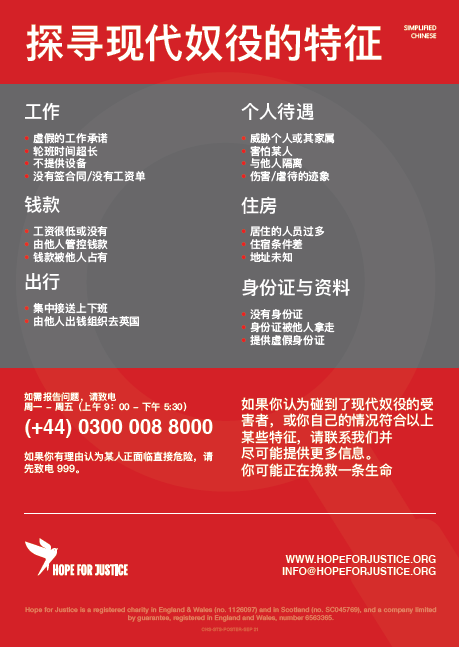
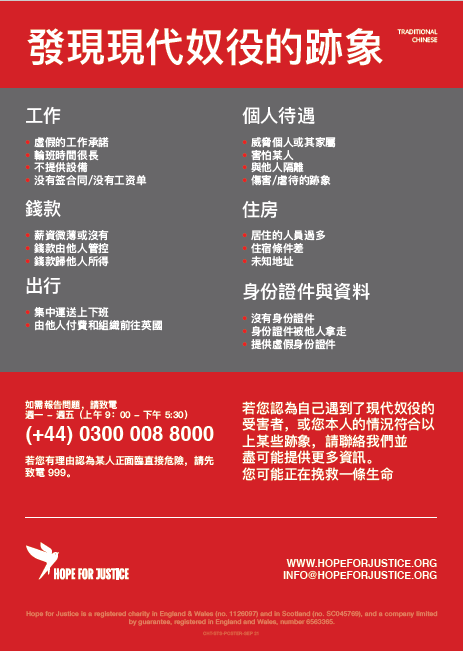
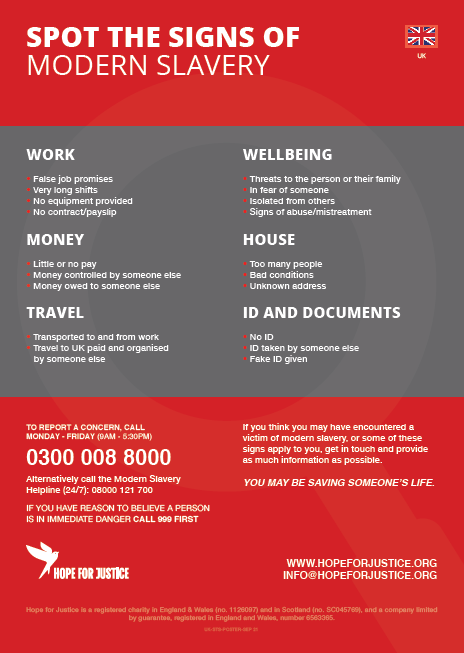
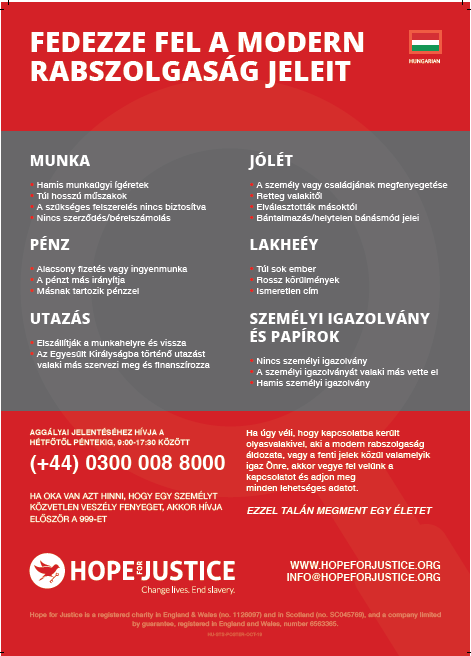
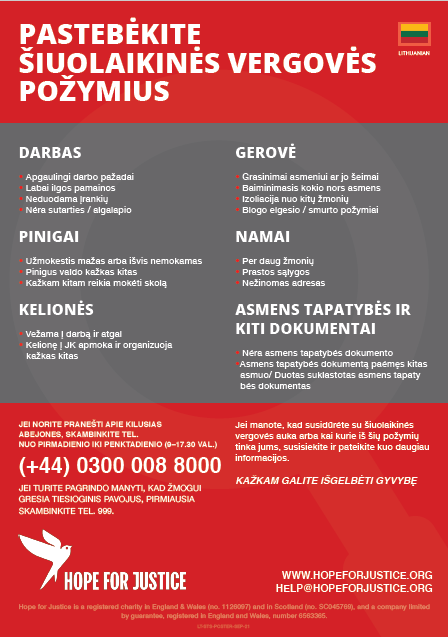
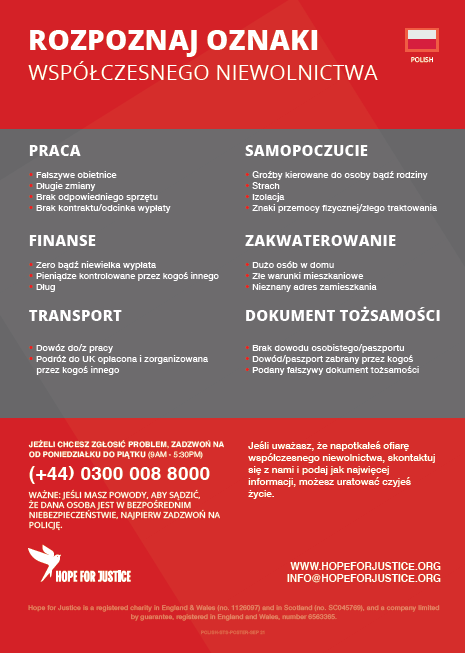
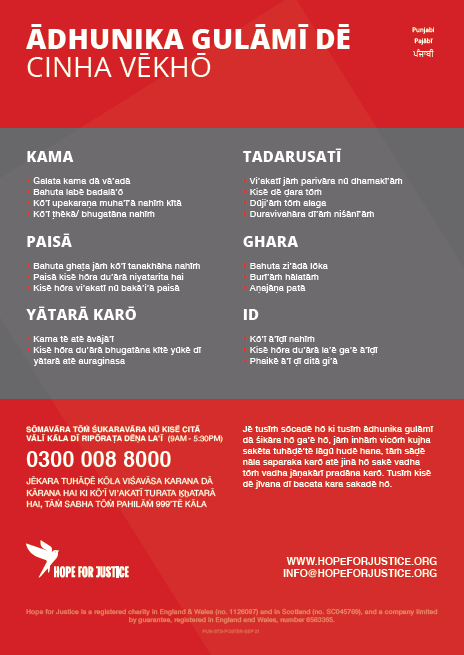
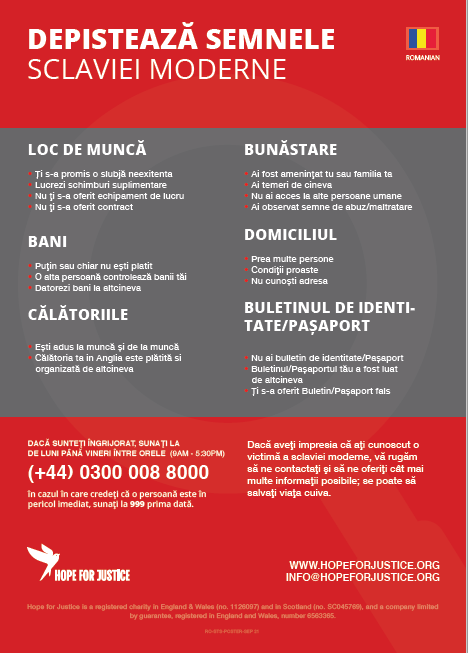
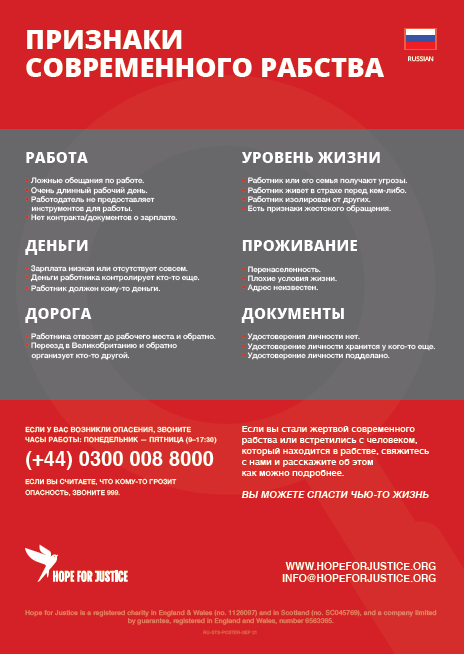
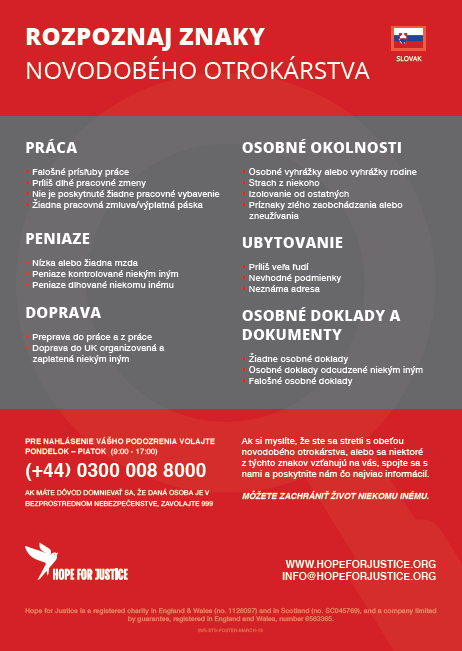

 View all our news
View all our news